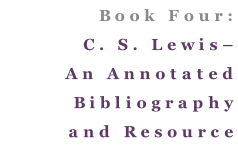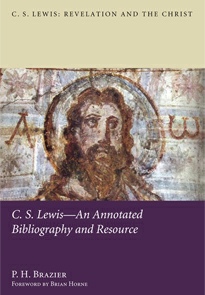

Revelation
The Christ



Outline
Contents
C. S. Lewis - An Annotated Bibliography and Resource
Introduction
Chapter 1. Lewis . . . and the Christ
Chapter 2. C. S. Lewis: An Annotated Historical Bibliography
of Primary Sources
Chapter 3. C. S. Lewis: Correspondent
Chapter 4. Helen Joy Davidman: An Annotated Historical Bibliography
Chapter 5. C. S. Lewis: Revelation and the Christ:
Secondary Sources–Books
Chapter 6. C. S. Lewis: Revelation and the Christ:
Secondary Sources–Articles and Essays
Chapter 7. Secondary Sources–Related to Lewis's Development
Chapter 8. Web Resources
Chapter 9. Glossary
Click here for a PDF file of the full detailed contents :


At the heart of C. S. Lewis–An Annotated Bibliography and Resource is a chronological bibliography of Lewis’s works.
This is complemented by an introductory essay on Lewis and Christology, a similar bibliography on the works of his wife, Joy Davidman, plus also a bibliography of secondary sources relating to Lewis’s doctrine of revelation and Christology, complemented by an inventory of web resources and a glossary of terms.
C.S. Lewis: Revelation and the Christ, Book Four
C. S. Lewis – An Annotated Bibliography, and Resource
Aims and Objectives
The three main volumes in this series are related, but are written to be read independently of each other. The aim of this volume is to provide a bibliography and resource to the three main volumes in this series, with the emphasis on the word, resource. Some readers will be teachers of theology in higher education – including professors; others who value Lewis’s work will be graduates (in other specialisms); still others will be knowledgeable Christians without formal higher education qualifications. This book as a resource should cater for all these groups, though not everything in this volume will be relevant to all of these readers.
As an annotated bibliography and resource this work opens with an explanation about The Christ, which then develops into an introductory essay on Christology (not everyone will be familiar with the technical terms and complex ideas that issue from the ancient Church in relation to what are sound ideas about Jesus). Having established this sound christological basis we can then briefly explore what Lewis’s understanding of Jesus – the Christ – is. This is then followed by several chapters that form a chronological introduction to the development of Lewis’s works, a copious bibliography of related secondary sources, and a guide to the study of Lewis. Then we have a guide to web resources on Lewis, and the Inklings. Finally a glossary for those unfamiliar with some of the background and terms to Lewis’s understanding of revelation and the Christ.
Detailed and copious indexes at the end of this volume allow access to authors cited and writers referenced, also subjects cited in the chapters, in addition all of Lewis’s works are listed alphabetically, and a detailed sectional contents assists navigation. A work like this will never be absolutely up-to-date, and human frailty dictates that the author may overlook or inadvertently omit a reference: apology is offered for any unintentional oversight. Essentially this is a volume that purports to answer some of the technical and detailed questions that readers of the three main volumes might come up with (though without fore knowledge of the questions, the answers may inevitably be general). Readers with specific questions to the main three books can contact through the “Contact” page on the dedicated website: www.cslewisandthechrist.net.
C. S. Lewis: An Annotated Historical Bibliography of Primary Sources
What is presented here is a chronological bibliography of books, novels and short stories, essays and academic papers, addresses and sermons; the works cited here give as complete a bibliography of primary sources as possible relating to Lewis’s Christology. This is a general chronological bibliography of the development of Lewis’s writings – orientated towards his doctrine of revelation and his understanding of the Christ.
In compiling this chronological bibliography all dates given are the year of composition of a work, or of its first publication. Many essays were re-printed several times, particularly in the decades following Lewis’s death; however, the purpose of this list is to illustrate the chronological development of Lewis’s thinking as evidenced by his various works. Therefore the key date is the date of publication, or, if earlier, the date of writing/composition, or, the date of delivery of an address/sermon. The volume of essays cited is then the first re-printing. Subsequent re-prints may be found in the many paperback volumes published in the last twenty years.
Lewis’s apologetics, philosophical theology, and other Christian writings, where they relate broadly to Christology and his doctrine of revelation, can be sub-divided according to how his work develops, in relation to the maturity of his faith, the events in his life, and the approach he took to apologetics and for that matter philosophy. Therefore, there are broadly three periods bounded by his conversion in 1931, the wartime Broadcast Talks (1941-1944), the Anscombe-Lewis debate in 1948, and his death in 1963: The Early Works 1931 to 1944; The Middle Works 1941 to 1947(a deliberate overlap is implied in these two periods); and The Later Works 1948 to 1963.
The Early Works: 1931-1944
Lewis’s The Pilgrim’s Regress, published in 1933 two years after his final conversion to belief in Christ as the Son of God, the revelation of God, was in some ways an intellectual apology for his conversion. In it he rejected the multivarious nineteenth and twentieth century philosophies and neo-Gnostic religious systems he had been seduced by. In the 1930s he published many academic papers relating to his work as a lecturer on English literature, however, during this period he was identifying and considering, gradually, his vocation as an orthodox biblical and creedal Christian, evidenced by his correspondence. His primary witness, initially, was in the common rooms of Oxford colleges. This led, in part, to the publication of his first implicitly Christian work: Out of the Silent Planet (1938). Further academic works in English literature followed, then in 1940 (instigated by Ashley Samson of the Centenary Press) The Problem of Pain was published. A clear work of apologetics this tackled one of the most difficult subjects for a Christian apologists: pain and affliction, anguish and suffering, and thereby theodicy: how do you justify God as good in the face of pain and suffering? The book was popular, and in effect, brought Lewis to the attention of the public. It led to the BBC radio broadcasts on the essence of the Christian faith.
The Middle Works: 1941-1947
Lewis is arguably at his most productive and confident as a preacher, apologist and philosophical theologian during the period of the middle works. This period overlaps the early period in that the radio broadcasts were initiated in 1941, and the early talks truly represent the learning and emerging confidence of Lewis as he found his feet, so to speak, in the 1930s. The later talks, from 1944, display the maturity and confidence that we find in many of his sermons, addresses and works in the 1940s. This assertive confidence, the ability to present a profound understanding in defence of the Christian faith and the truth of the Gospel, is found in the sermon, The Weight of Glory, and apologetic narratives such as The Screwtape Letters, these typify the self-assurance of the middle period works, and originate in 1941, whilst Lewis was still working on the early broadcast talks. Before the radio broadcasts were over he had produced The Great Divorce and begun writing his seminal definition of the relationship between Platonism and the Gospel (which in effect defined in limited terms the mechanism whereby the Holy Spirit relates to and acts in our world, our reality): an address entitled, Transposition (delivered at Mansfield College just after the conclusion of the final series of broadcast talks). There are many essays and sermons which characterise the self-assured argumentative nature of Lewis’s apologetics during this period, which culminates with the first edition of Miracles, still one of Lewis’s most cogent arguments for the supernatural nature of the Christian faith.
The Later Works: 1948-1963
In 1948 Lewis had what was to many a bruising encounter with a young philosophy don at the Oxford Socratic Club: Elizabeth Anscombe. An analysis of this along with the nature of Lewis as a philosopher, raises complex issues about revelation and reason, the use of language and how we “know;” however, this debate in effective marks a slowly developing change in his work, with less of an emphasis on assertive apologetics. Foremost, indeed characteristic of in many ways, this later period are The Chronicles of Narnia. There are also many devotionally based works, which also characterise a developing interest in Lewis’s mature work: Christlikeness. For example, Till We Have Faces (1956), Reflections on the Psalms (1958), and the posthumously published, Letters to Malcolm: Chiefly on Prayer (1964). There is also a wealth of essays of philosophical theology, and important correspondence that develop Lewis’s mere Christology.

Download this essay in PDF:
PDF :: C.S. Lewis–An Annotated Bibliography and Resource
If citing this essay please use the following:
P.H. Brazier, ‘C.S. Lewis–An Annotated Bibliography and Resource’
www.cslewisandthechrist.net/csl_annotated_bibliography_&_resource.html.
and then give paragraph numbers and date accessed
PDF:



Home
Book One
Book Two
Book Three
Book Four
Links
Contact
“In the Highest Degree”








Author

